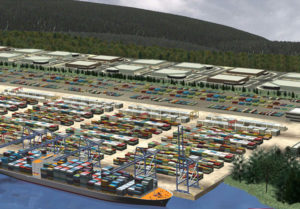A recent report suggesting the Province of Nova Scotia concentrate port development in Halifax is justifiably drawing criticism.
Recently, CPCS Consultants issued a report that recommended efforts at terminal development take precedence in the Halifax Regional Municipality, over areas of the province like Sydney and the Strait of Canso.
Richie Mann, vice president of marketing with Melford International Terminal (MIT), referred to the report as “amateur.” Although MIT was interviewed for the report, Mann claimed “either what we said wasn’t understood, or perhaps it was just ignored.”
MIT, as well as officials with the Municipality of the District of Guysborough, charged the consultants did not recognize the value of the Melford proposal, and overlooked the important fact that this project is backed by private capital.
Although the Department of Transportation and Infrastructure Renewal and the Atlantic Canada Opportunities Agency funded the report, Mann was quick to point out that the transportation minister has not endorsed it, and with good cause.
The Melford project has the potential to provide good paying, long-term jobs, stimulate economic activity and act as a catalyst for more development, all without costing Nova Scotia taxpayers.
On June 6, Cyrus Capital Partners, the majority owner of MIT, announced a joint venture and investment with SSA Marine for the newly dubbed Melford Atlantic Gateway, a 315-acre container terminal, with 250 acres of logistics park lands and the corridor necessary to build 32 kilometers of rail spur to connect with the existing rail line.
That is exactly the type of proposal that can heal the wounded economy of rural Nova Scotia.
Areas outside the HRM have witnessed massive job losses, investment and capital leaving, little to no development or economic activity taking place, and cuts in public services, programs and employees since the early 1990s.
Many rural Nova Scotians long ago abandoned the idea that government is going to turn around their fortunes and there is general agreement that private investment and development is an important avenue through which to attain growth.
This consensus has been reached, partly out of necessity, as provincial coffers dry up, and after witnessing the mistakes of the past, when publicly-subsidized companies came and went, with little to no lasting economic footprint.
The most puzzling aspect of what should be a pretty cut and dried issue is why some media, politicians, groups, businesses, and others – some of which rely on the support of Nova Scotians outside HRM – would so blatantly support this misinformed report.
This report completely overlooked the glaring reality that port development in the HRM will not benefit the entire province as the same activity would in more economically challenged regions.
For proof, look at recent years. While rural Nova Scotia continued to bleed, the economy of HRM continued chugging along solidly. If it is true that what benefits the HRM benefits all Nova Scotians, the consistent economy of HRM would have helped stop the backslide of rural Nova Scotia years ago.
This report clearly illustrates the opposing forces at work in this province: a rural Nova Scotia working toward self sufficiency, that is forced to compete against vested self-interests in the HRM.
If this province is ever going to improve, it’s time all Nova Scotians get on the same page, stop working against each other and do what is right for all parts of the province.



